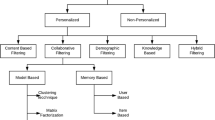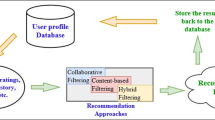Abstract
The recommendation system is a good choice to provide users with personalized services. Facing with a large amount of data, clustering technology can group similar users into one category, which can make more rapid and accurate recommendations for target users. Due to user’s interests changing over time, how to make reasonable recommendations is an important issue. In this article, an improved k-means clustering algorithm based on cuckoo search is proposed and an improved time correlation coefficient is added to the algorithm to improve the accuracy of recommendation system. The proposed clustering algorithm integrates intra-cluster compactness and inter-cluster separation, which can improve the similarity of users in the same cluster. The proposed time correlation coefficient creatively considers both the inherent connection between user’s preference and time, and the impact of the periodicity and continuity of time on user rating patterns.







Similar content being viewed by others
References
Fan X et al (2017) CASR-TSE: context-aware web services recommendation for modeling weighted temporal-spatial effectiveness. IEEE Trans Serv Comput 14(1):58–70
Chen J et al (2021) Dynamic clustering collaborative filtering recommendation algorithm based on double-layer network. Int J Mach Learn Cybern 12(4):1097–1113
Cui Z et al (2020) Personalized recommendation system based on collaborative filtering for IoT scenarios. IEEE Trans Serv Comput 13(4):685–695
Li D et al (2021) Mixture matrix approximation for collaborative filtering. IEEE Trans Knowl Data Eng 33(6):2640–2653
Bu J et al (2016) Improving collaborative recommendation via user-item subgroups. IEEE Trans Knowl Data Eng 28(9):2363–2375
Yeon-Chang L et al (2016) Exploiting uninteresting items for effective collaborative filtering. 2016 IEEE 32nd International Conference on Data Engineering (ICDE) pp:349-360
Wang S et al (2016) Ranking-oriented collaborative filtering: a listwise approach. ACM Trans Inform Syst (TOIS) 35(2):1–28
Wu X et al (2017) Collaborative filtering service recommendation based on a novel similarity computation method. IEEE Trans Serv Comput 10(3):352–365
Lu Q et al (2019) User-based collaborative filtering recommendation method combining with privacy concerns intensity in mobile commerce. Int J Wireless and Mobile Comput 17(1):63–70
Han D et al (2022) Implicit social recommendation algorithm based on multilayer fuzzy perception similarity. Int J Mach Learn Cybern 13(2):357–369
Wang CD et al (2018) Serendipitous recommendation in e-commerce using innovator-based collaborative filtering. IEEE Trans Cybern 49(7):2678–2692
Zhang Q et al (2018) Coupledcf: Learning explicit and implicit user-item couplings in recommendation for deep collaborative filtering. IJCAI International Joint Conference on Artificial Intelligence
Xue F et al (2019) Task allocation of intelligent warehouse picking system based on multi-robot coalition. KSII Trans Internet and Inform Syst (TIIS) 13(7):3566–3582
Zhang W, Wang J (2015) A collective bayesian poisson factorization model for cold-start local event recommendation. Proceedings of the 21th ACM SIGKDD international conference on knowledge discovery and data mining pp:1455-1464
Long L et al (2022) Multi-task learning for collaborative filtering. Int J Mach Learn Cybern 13:1355–1368
Xiao S et al (2022) Lecf: recommendation via learnable edge collaborative filtering. Sci China (Inform Sci) 65(1):116–130
Lian D et al (2016) Regularized content-aware tensor factorization meets temporal-aware location recommendation. 2016 IEEE 16th international conference on data mining (ICDM) pp:1029-1034
Feng J et al (2021) RBPR: a hybrid model for the new user cold start problem in recommender systems. Knowl-Based Syst 214:0950–7051
Guo G et al (2018) PCCF: periodic and continual temporal co-factorization for recommender systems. Inform Sci 426:56–73
Meng S et al (2020) Temporal-aware and sparsity-tolerant hybrid collaborative recommendation method with privacy preservation. Concurr Comput Pract Exp 32(2):e5447
Li, Bin and et al (2011) Cross-domain collaborative filtering over time. Twenty-Second International Joint Conference on Artificial Intelligence
Zhou Z et al (2016) Scientific workflow clustering and recommendation leveraging layer hierarchical analysis. IEEE Trans Serv Comput 11(1):169–183
Shanmuga Sundari P et al (2020) Integrating sentiment analysis on hybrid collaborative filtering method in a big data environments. Int J Inform Technol Decis Mak 19(2):385–412
Al-Sabaawiand AAM et al (2021) A novel overlapping method to alleviate the cold-start problem in recommendation systems. Int J Softw Eng Knowl Eng 31(9):1277–1297
Faryad T et al (2021) A hybrid recommendation system based on profile expansion technique to alleviate cold start problem. Multimed Tools Appl 80(2):2339–2354
Salah A et al (2016) A dynamic collaborative filtering system via a weighted clustering approach. Neurocomputing 175:206–215
Ahn HJ (2008) A new similarity measure for collaborative filtering to alleviate the new user cold-starting problem. Inform Sci 178(1):37–51
Liu H et al (2014) A new user similarity model to improve the accuracy of collaborative filtering. Knowl-Based Syst 56:156–166
Deng J et al (2019) A novel K-medoids clustering recommendation algorithm based on probability distribution for collaborative filtering. Inform Sci 175:96–106
Wang Y et al (2017) A hybrid user similarity model for collaborative filtering. Inform Sci 418:102–118
Jing L et al (2007) An entropy weighting k-means algorithm for subspace clustering of high-dimensional sparse data. IEEE Trans Knowl Data Eng 19(8):1026–1041
Huang X et al (2013) Extensions of kmeans-type algorithms: a new clustering framework by integrating intracluster compactness and intercluster separation. IEEE Trans Neural Netw Learn Syst 25(8):1433–1446
Shamir O et al (2010) Stability and model selection in k-means clustering. Mach Learn 80(2–3):213–243
Huang X et al (2014) DSKmeans: a new kmeans-type approach to discriminative subspace clustering. Knowl-Based Syst 70:293–300
Arthur D et al (2007) k-means ++: the advantages of careful seeding. In: Proceedings of the eighteenth annual ACM-SIAM symposium on Discrete algorithms, pp 1027–1035
Pelleg D et al (2000) X-means: extending k-means with efficient estimation of the number of clusters. In: Proceedings of international conference on machine learning
DeSarbo WS et al (1984) Synthesized clustering: a method for amalgamating alternative clustering bases with differential weighting of variables. Psychometrika 49(1):57–78
Chen X et al (2011) TW-k-means: automated two-level variable weighting clustering algorithm for multiview data. IEEE Trans Knowl Data Eng 25(4):932–944
Amir A et al (2022) Tadaptive explicit kernel minkowski weighted K-means. Inform Sci 584:503–518
Li Y et al (2022) Multi-view k-means clustering with adaptive sparse memberships and weight allocation. IEEE Trans Knowl Data Eng 34(2):816–827
Song K et al (2021) Weighted bilateral K-means algorithm for fast co-clustering and fast spectral clustering(Article). Pattern Recognit 109:107560
Shardanand U (1995) Social information filtering : algorithms for automating ’word of Mouth’. Proc. CHI’95 Conference on Human Factors in Computing Systems pp:210-217
Sarwar B et al (2001) Item-based collaborative filtering recommendation algorithms. Proc. CHI’95 Conference on Human Factors in Computing Systems pp:285-295
Zhang R, Hu Z (2020) Collaborative filtering recommendation algorithm based on Bee Colony K-means clustering model. Microprocessors and Microsystems pp:103424
Liu J et al (2021) A hybrid news recommendation algorithm based on k-means clustering and collaborative filtering. J Phys Conf Ser 1881(3):032050
Acknowledgements
This research is jointly supported by Photovoltaic Industry Production Production Integration Comprehensive Demonstration Base of Sichuan Province (Sichuan Financial Education [2022] No.106),the project of Sichuan Provincial Department of Education (No. JG2021-550), and the key project of Southwest Petroleum University (No.X2021JGZDI033). The numerical calculations in this paper have been done on the super-computing system in the Supercomputing Center for science and engineering of Southwest Petroleum University.
Author information
Authors and Affiliations
Corresponding author
Additional information
Publisher's Note
Springer Nature remains neutral with regard to jurisdictional claims in published maps and institutional affiliations.
Rights and permissions
Springer Nature or its licensor (e.g. a society or other partner) holds exclusive rights to this article under a publishing agreement with the author(s) or other rightsholder(s); author self-archiving of the accepted manuscript version of this article is solely governed by the terms of such publishing agreement and applicable law.
About this article
Cite this article
Lan, R., Tian, D., Wu, Q. et al. An improved collaborative filtering model based on time weighted correlation coefficient and inter-cluster separation. Int. J. Mach. Learn. & Cyber. 14, 3543–3560 (2023). https://doi.org/10.1007/s13042-023-01849-y
Received:
Accepted:
Published:
Issue Date:
DOI: https://doi.org/10.1007/s13042-023-01849-y




